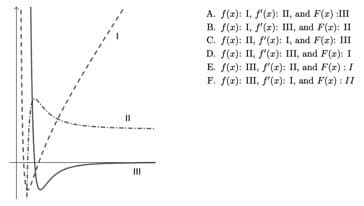A. f(x): I, f'(z): II, and F(z) :III B. f(r): I, f'(z): III, and F(r): II C. f(z): II, f'(z): I, and F(z): III D. f(x): II, f'(z): III, and F(z): I E. f(r): III, f"(r): II, and F(z) : I F. f(z): III, f'(x): I, and F(z) : II
A. f(x): I, f'(z): II, and F(z) :III B. f(r): I, f'(z): III, and F(r): II C. f(z): II, f'(z): I, and F(z): III D. f(x): II, f'(z): III, and F(z): I E. f(r): III, f"(r): II, and F(z) : I F. f(z): III, f'(x): I, and F(z) : II
Algebra & Trigonometry with Analytic Geometry
13th Edition
ISBN:9781133382119
Author:Swokowski
Publisher:Swokowski
Chapter7: Analytic Trigonometry
Section7.6: The Inverse Trigonometric Functions
Problem 91E
Related questions
Question
-
Let f(x) be a continuous and differentiable function, and let F(x) be antiderivative of f. Shown on the axes below are the graphs of y = f(x), y = f′(x), and y = F (x). Determine which graph is which, and circle one correct response below.

Transcribed Image Text:A. f(z): I, f'(z): II, and F(z) :III
B. f(r): I, f'(z): III, and F(r): II
C. f(r): II, f'(x): I, and F(z): III
D. f(r): II, f'(x): III, and F(z): I
E. f(r): III, f'(r): II, and F(z) : I
F. f(z): III, f'(x): I, and F(z) : II
Expert Solution
This question has been solved!
Explore an expertly crafted, step-by-step solution for a thorough understanding of key concepts.
Step by step
Solved in 2 steps with 2 images

Recommended textbooks for you

Algebra & Trigonometry with Analytic Geometry
Algebra
ISBN:
9781133382119
Author:
Swokowski
Publisher:
Cengage

Algebra & Trigonometry with Analytic Geometry
Algebra
ISBN:
9781133382119
Author:
Swokowski
Publisher:
Cengage